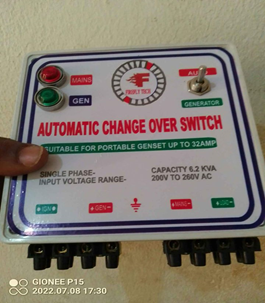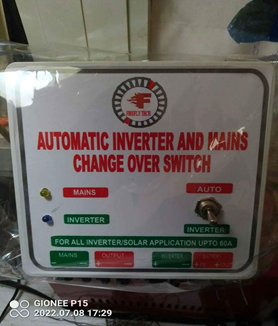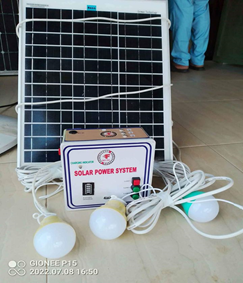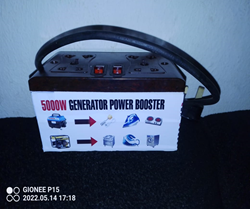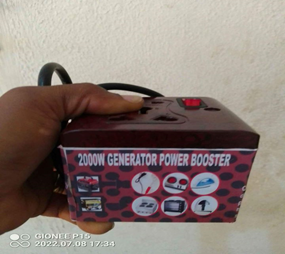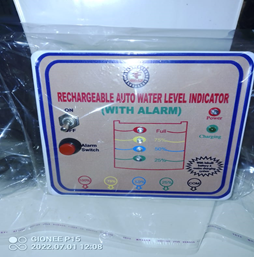GEOELECTRICAL IMAGING OF GROUNDWATER POLLUTION
USER'S INSTRUCTIONS: The project work you are about to view is on "geoelectrical imaging of groundwater pollution". Please, sit back and study the below research material carefully. This project topic (geoelectrical imaging of groundwater pollution) have complete 5(five) Chapters. The complete Project Material/writeup include: Abstract + Introduction + etc + Literature Review + methodology + etc + Conclusion + Recommendation + References/Bibliography.Our aim of providing this "geoelectrical imaging of groundwater pollution" project research material is to reduce the stress of moving from one school library to another all in the name of searching for "geoelectrical imaging of groundwater pollution" research materials. We are not encouraging any form of plagiarism. This service is legal because, all institutions permit their students to read previous projects, books, articles or papers while developing their own works.
TITLE PAGE
BY
---
--/H2013/01430
DEPARTMENT OF ----
SCHOOL OF ---
INSTITUTE OF ---
DECEMBER,2018
APPROVAL PAGE
This is to certify that the research work, "geoelectrical imaging of groundwater pollution" by ---, Reg. No. --/H2007/01430 submitted in partial fulfillment of the requirement award of a Higher National Diploma on --- has been approved.
By
--- . ---
Supervisor Head of Department.
Signature………………. Signature……………….
……………………………….
---
External Invigilator
DEDICATION
This project is dedicated to Almighty God for his protection, kindness, strength over my life throughout the period and also to my --- for his financial support and moral care towards me.Also to my mentor --- for her academic advice she often gives to me. May Almighty God shield them from the peril of this world and bless their entire endeavour Amen.
ACKNOWLEDGEMENT
The successful completion of this project work could not have been a reality without the encouragement of my --- and other people. My immensely appreciation goes to my humble and able supervisor mr. --- for his kindness in supervising this project.
My warmest gratitude goes to my parents for their moral, spiritual and financial support throughout my study in this institution.
My appreciation goes to some of my lecturers among whom are Mr. ---, and Dr. ---. I also recognize the support of some of the staff of --- among whom are: The General Manager, Deputy General manager, the internal Auditor Mr. --- and the ---. Finally, my appreciation goes to my elder sister ---, my lovely friends mercy ---, ---, --- and many others who were quite helpful.
PROJECT DESCRIPTION: This work "geoelectrical imaging of groundwater pollution" research material is a complete and well researched project material strictly for academic purposes, which has been approved by different Lecturers from different higher institutions. We made Preliminary pages, Abstract and Chapter one of ""geoelectrical imaging of groundwater pollution visible for everyone, then the complete material on "geoelectrical imaging of groundwater pollution" is to be ordered for. Happy viewing!!!
A resistivity survey was made in a dumpsite in order to determine the quality of the ground water in that area. The vulnerability of overburden aquifers at the vicinity of a municipal dumpsite has been carried out. The survey site is bounded by longitude 7°5′20′′ and 7°5′52′and latitudes 6°13′35′′ and 6°13′52 located within Niger delta basin of Southeastern Nigeria. Two-dimensional electrical resistivity tomography (2DERT) and vertical electrical sounding (VES) techniques were carried out in order to ascertain the extent of the vulnerability of groundwater at shallow subsurface. The registered resistivity values modeled in the 2DERT and VES are in the ranges of about 3.76 Ωm to 11464 Ωm and about 76.79 Ωm to 5665.85 Ωm respectively. With the aid of Res2D inversion version 3.2 and Winglet version 1.62 software, the 2DERT and VES data were modeled respectively. Interpreted 2DERT results showed evidence of the leachate in clayey and sandy topsoil the refuse dump. Inferred fractures in both top and other shallow layers suggest percolation of the leachate into depths beyond the limits probed by the 2DERT. Interpreted results from the VES showed that longitudinal conductivities 𝑆𝐿 derived for depths in the study site is in the range of about 0.002161 - 0.101741 mhos. Hence, Dar Zarrouk Parameter (DZP) standard was used to evaluate the protective capacity of groundwater’s overburden at the site and its vulnerability. Based on the interpreted 2DERT, there is evidence of leachate percolation through the topsoil and shallow subsurface to depths. The protective capacity of the depths underlain by the groundwater was inferred as weak at NNE and Eastern zones of the dumpsite while at the SSE and the Western zones of the dumpsite was inferred as poor. Consequently, the vulnerability of the groundwater in the vicinity of Awka municipal dumpsite to percolating leachate from refuse dump is moderately high.
TABLE OF CONTENTS
COVER PAGE
TITLE PAGE
APPROVAL PAGE
DEDICATION
ACKNOWLEDGEMENT
ABSTRACT
CHAPTER ONE
1.0 INTRODUCTION
1.1 BACKGROUND OF THE STUDY
- DEFINITION AND CAUSES OF GROUNDWATER POLLUTION
- PROBLEM STATEMENT
- AIM AND OBJECTIVE OF THE PROJECT
- SIGNIFICANCE OF STUDY
- SCOPE OF STUDY
- LIMITATIONS TO STUDY
- PROCEDURES INVOLVED IN THE STUDY
- BASIC TERMS IN GROUNDWATER STUDY
- THE STUDY SITE
CHAPTER TWO
LITERATURE REVIEW
- GEOELECTRIC IMAGING
- GROUNDWATER
- GROUNDWATER EVALUATION
- RELEVANCE OF GEOELECTRIC IMAGING IN GROUNDWATER EVALUATION
- FACTORS THAT FACILITATE OR IMPEDE GROUNDWATER EVALUATION VIA GEOELECTRIC IMAGING
CHAPTER THREE
3.0 MATERIALS AND METHOD
CHAPTER FOUR
4.0 RESULTS AND DISCUSION
- RESULT
- DISCUSSION
CHAPTER FIVE
- CONCLUSION
- RECOMMENDATION
REFERENCES
CHAPTER ONE
1.0 INTRODUCTION
1.1 BACKGROUND OF STUDY
Groundwater utilization as a source of fresh water supply for various purposes in discharge area shows an ever to increasing trend, while land use of recharges also changes as development progresses. To meet its needs, many people rely on land-based exploration and exploitation. Groundwater is one of nature's most valuable and inseparable resources for life on earth.
Surprisingly for a resource that is so widely used and so important to health and to the economy of the country, the occurrence of ground water is not only poorly understood but is also, in fact , the subject of many widespread misconceptions. Common misconception includes the belief that ground water occurs in underground rivers resembling surface streams whose presence can be detected by certain individuals. These misconceptions and others have hampered the development and conservations of ground water and have adversely affected the protection of its quality.Groundwater occurs everywhere but sometimes its availability in economic quantity depends solely on the distribution of the subsurface geomaterials that are referred to as the aquifers. This implies that where groundwater is not potentially endowed enough, there may be either complete lack or inadequacy due to increasing industrial and domestic needs.
Pollution occurs when the concentration of various chemical or biological constituents exceed a level at which a negative impact on amenities, the ecosystem, resources and human health can occur. Pollution results primarily from human activities. There are different sources of pollution. When they are chemical or biological constituents creating pollution they are known as contaminants. Contaminants degrade the natural quality of a substance or medium. It can either be organic or inorganic.
Surface resistivity methods have been employed successfully for detecting and mapping ground-water contamination under a variety of conditions. The method is based on the fact that formation resistivity depends on the conductivity of the pore fluid as well as the properties of the porous medium. Under favorable conditions, contrasts in resistivity may be attributed to mineralized groundwater with a higher than normal specific conductance originating at a contamination source. Success with surface resistivity methods depends to a large extent on a good knowledge of subsurface conditions. Conditions favorable for delineating zones of contamination include uniform subsurface conditions, a shallow groundwater table, and good electrical contrast between mineralized and natural water.
One of the primary problems in field investigations of groundwater pollution is locating the contaminant plume. In most cases, the goal is to positively locate the pollutant and its movement by test holes and direct monitoring. In the interest of efficiency the investigative areas should be as focused as possible. In many cases a general knowledge of local hydrogeology allows a reasonable initial estimate of pollutant direction; in other instances even this may be lacking. Drilling of sampling holes on a hit-or-miss basis is both time-consuming and expensive. It can also be destructive to the property involved. Under certain subsurface conditions, surface geoelectrical profiling can quickly and cheaply locate the general location of the plume and identify areas most feasible for sampling and monitoring.
Numerous investigations have established the usefulness of surface electrical resistivity as a tool in the detection of ground water contamination.
1.2 DEFINITION AND CAUSES OF GROUNDWATER POLLUTION
Pollution has been found to be much more widespread than we had believed only a few years ago. Polluted ground water may pose a serious threat to health. Pollution of ground water refers to any deterioration in quality of the water resulting from the activities of man. Most pollution of ground water results from the disposal of wastes on the land surface, in shallow excavations including septic tanks, use of fertilizers, leak in sewers and pipelines. The magnitude of any pollution problem depends on the size of the area affected and the amount of the pollutant involved, the solubility, toxicity, and density of the pollutant, the mineral composition and the hydraulic characteristics of the soils and rocks through which the pollutant moves, and the effect or potential effect on ground-water use.
1.3 STATEMENT OF PROBLEM
Groundwater exploration requires appropriate and efficient techniques. One commonly used method is geoelectrical imaging. it is efficient and economical to determine groundwater. Geoelectric imaging is one of the variables which is the physical properties of the rock layers below the surface. Rock resistivity data can be used to develop a model of subsurface and stratigraphic structures in terms of electrical properties. Geoelectric resistivity depends on lithology, air content, porosity, and pore ions concentration. This work is on the use of geoeletric imaging in groundwater evaluation.
Here this study focuses mainly on the impact of Groundwater pollution in a dump site area and how it can be evaluated using resistivity method. But first I will like to discuss briefly about the impact of pollution on Groundwater before giving reasons of using resistivity method on ground water pollution in a dump site.
1.4 AIM AND OBJECTIVES
The aim of this work is to detect, delineate and denominate the extent of contaminant intrusion on ground water in an area, with the following objectives in mind:
- To evaluate the quality of groundwater
- To study the geo electrical properties of the sub surface to depth in other to estimate contamination degree.
- To uncover the direction of pollutant flow relative to the ground water flow.
- To study the geoelectrical properties of the sub surface to depth in other to estimate contamination degree.
- To uncover the direction of pollutant flow relative to the ground water flow.
- To assess and map the vertical and lateral extent of contaminated groundwater into sub surface and how much ground water area it covered.
- To distinguish between polluted and non – polluted zones with respect to the groundwater contamination.
1.5 SIGNIFICANCE OF STUDY
The significance of the above study is important in following ways:
It will provide useful information on the condition of ground water at dump site areas which can serve as a useful tool in environmental impact assessment (EIA), of that area.
Information about water flow direction will assist in the design of efficient and cost-effective monitoring networks and remediation strategies of ground water pollution.
Geoelectric details of the subsurface gotten from this study will give sound knowledge of the sub surface geology including infiltration and percolation process is prerequisite for managing contaminant transport in the saturated or aquifer zone.
1.5 SCOPE OF STUDY
The scope of this study covers investigating the pollution of groundwater at the vicinity of the municipal dumpsite using two-dimensional electrical resistivity tomography (2DERT) and Vertical Electrical Sounding techniques (VES). On one hand, the shallow subsurface 2DERT is meant to delineate the occurrence of pollutants such as leachate in the topsoil and their tendency of percolation to depths. On the other hand, the VES is meant to probe the lithology of deeper subsurface hence estimate the extent of its protective capacity on the groundwater which underlie it. The results from the study will be beneficial to government, community and researchers for determination of environmental friendliness of the dumpsite hence, aid the future recommendation of other site(s) for same purpose.
1.6 LIMITATIONS TO STUDY
Electrical resistivity profiling is simple in concept but has a number of significant practical limitations.
Equipment range: The extreme limit for spread of the current electrodes, and consequently the depth of penetration of the current generator and the resistivity characteristics of the soil being measured. Highly resistive layers such as thick unsaturated zone require considerable current before the underlying saturated material can be sensed.
Physical obstructions: In many situations, it is difficult to establish a long continuous electrode spread or profile line because of physical obstructions. These may include rocks, trees, bulidings, paved areas and the like.
Electrical interferences: A careful check must be made of the area to be surveyed for any electrical inducing or conductive features. These include overhead and buried power lines, metal fences, above-ground and buried water lines, railroad tracks, and conductive pipes of all kinds. As a general rule one must be at least as far away from such interference as the "A" spacing.
Topographic variations: The model assumes that the resistivity layers are uniform in thickness and infinite in extent. In hilly or rugged terrain, it becomes impossible to determine whether the observed change is due to subsurface variation in hydrogeology or to topographic changes.
Hydrogeologic variations: Changes in soil type zone can mask the effects of pore-water resistivity change. The presence of silt and particularly clay will lower the apparent resistivity substantially and can easily be mistaken for a change in pore-water resistivity. Accordingly where such materials may occur, electrical interpretations should be made with reservation.
1.7 PROCEDURES INVOLVED IN THE STUDY
The following procedure is recommended for surface resistivity profiling:
Develop a hydrogeologic concept for the area to be investigated. Available geological and ground-water studies should be reviewed. If available, boring logs and water quality data should be obtained. From these, the pattern of ground-water flow and general resistivity model can be ascertained.
- Make a field survey of the area.
- Determine Profile Location: Based on the results of items 1 and 2, the selection of profile locations can be made. The profile line should cross the anticipated plume location, beginning and ending clearly on either side of the probable contaminated zone.
- Make Field Preparations: The line should be cleared and the electrode positions clearly marked in advance. Much time during the actual profiling can be saved by good site preparation. Equipment, especially condition of batteries and integrity of electrical wire, should be checked carefully before proceeding to the field.
- Make Vertical electrical sounding: At least one electrical sounding and preferably more should be made at the site to ascertain the most appropriate "A" spacing(s). Ideally these soundings should be made in an uncontaminated zone. The soundings should confirm the hydrogeologic model developed from item 1.
- Run Profiles: The profiles are then run at the selected A spacings and at a station separation no more than one-third the estimated plume width. Preliminary calculations of apparent resistivity should be made in the field; this allows for additional readings to be taken if results seem unusual or a region of electrical anomaly is encountered.
- Perform analysis of Data: Analysis is made from plots of the calculated apparent resistivity against profile stations. The contaminated region should then appear as an anomalous low in the profile plot. If such a low does not appear, the sounding curve, available information and field conditions should be reexamined for a more sensitive electrode spacing, possible electrical interferences, or infeasibility of the method due to lack of sufficient pore-water contrast.
1.8 BASIC TERMS IN GROUNDWATER STUDY
1.8.1 AQUIFER: An aquifer is a ground-water reservoir composed of geologic units that are saturated with water and sufficiently permeable to yield water in a usable quantity to wells and springs. Sand and gravel deposits, sandstone, limestone, and fractured crystalline rocks are examples of geological units that form aquifers. Aquifers provide two important functions:
(1) They transmit ground water from areas of recharge to areas of discharge, and
(2)They provide a storage medium for useable quantities of groundwater. The amount of water a material can hold depends upon its porosity. The size and degree of interconnection of those openings (permeability) determine the materials’ ability to transmit fluid.
UNCONFINED AQUIFERS
An unconfined aquifer is one in which a water table varies in undulating form and in slope, depending on areas of recharge and discharge, pumpage from wells, and permeability. Rises and falls in the water table correspond to changes in the volume of water in storage within an aquifer.
Figure 1 shows an idealized section through an unconfined aquifer; the upper aquifer in is also unconfined. Contour maps and profiles of the water table can be prepared from elevations of water in wells that tap the aquifer to determine the quantities of water available and their distribution and movement. A special case of an unconfined aquifer involves perched water bodies (Figure 1). This occurs wherever a groundwater body is separated from the main groundwater by a relatively impermeable stratum of small areal extent and by the zone of aeration above the main body of groundwater. Clay lenses in sedimentary deposits often have shallow perched water bodies overlying them. Wells tapping these sources yield only temporary or small quantities of water.
CONFINED AQUIFERS
Confined aquifers, also known as artesian or pressure aquifers, occur where groundwater is confined under pressure greater than atmospheric by overlying relatively impermeable strata. In a well penetrating such an aquifer, the water level will rise above the bottom of the confining bed, as shown by the artesian and flowing wells. Water enters a confined aquifer in an area where the confining bed rises to the surface; where the confining bed ends underground, the aquifer becomes unconfined. A region supplying water to a confined area is known as a recharge area; water may also enter by leakage through a confining bed. Rises and falls of water in wells penetrating confined aquifers result primarily from changes in pressure rather than changes in storage volumes. Hence, confined aquifers display only small changes in storage and serve primarily as conduits for conveying water from recharge areas to locations of natural or artificial discharge.
Figure 1: Schematic Cross-sections of Aquifer Types (Modified after Hartan et al, 1989)
LEAKY AQUIFER
Aquifers that are completely confined or unconfined occur less frequently than do leaky, or semi-confined, aquifers. These are a common feature in alluvial valleys, plains, or former lake basins where a permeable stratum is overlain or underlain by a semi-pervious aquitard or semi-confining layer. Pumping from a well in a leaky aquifer removes water in two ways: by horizontal flow within the aquifer and by vertical flow through the aquitard into the aquifer.
1.8.2 AQUITARD
An aquitard is a partly permeable geologic formation. It transmits water at such a slow rate that the yield is insufficient. Pumping by wells is not possible. For example, sand lenses in a clay formation will form an aquitard.
1.8.3 AQUICLUDE
An aquiclude is composed of rock or sediment that acts as a barrier to groundwater flow. Aquicludes are made up of low porosity and low permeability rock/sediment such as shale or clay. Aquicludes have normally good storage capacity but low transmitting capacity.
1.9 THE STUDY SITE
The dumpsite used in this study is located at the industrial layout of Awka-North where there is also a new residential layout sited. The study site is located at about 500 m off Ring Road junction Awka, Anambra State Nigeria. The area is bounded by latitudes 6°13′35′′N and 6°13′52′′N and longitudes 7°5′15′′E and 7°5′16′′E at the elevation of about 180 m above mean sea level. Figure 1 shows the base map of the survey site showing the VES points and profile lines Two main climatic seasons characterize the study area; the rainy season which is associated with the moist maritime southwesterly trade wind from the Atlantic Ocean and the dry season which is associated with the Atlantic Continental northwesterly wind from the Sahara Desert. The average time window for rainy season and dry season are April to October and November to March respectively. Between the two seasons is the occurrence of short-lived cold-dry season which is characterized by low temperature, hazy and dusty atmosphere southeasterly from Sahara Desert.
The study site lies within the Niger Delta Basin of Southeastern Nigeria. The Basin is in the Gulf of Guinea in equatorial West Africa, it lies between latitudes 3oN and 6oN and longitudes 5oE and 8oE (Reijers et al., 1996). Niger Delta is a prograding depositional complex within the Cenozoic Formation of the Southern Nigeria, bounded in the west of it by the Benin flank; the subsurface continuation of the West Africa shield, bounded in the east by Calabar flank; the subsurface continuation of the Oban massif, in the North by Abakaliki and the post-Abakaliki (Anambra Basin) and bounded in the south by Atlantic Ocean (Murat, 1972). The outcropping units of the Niger Delta include Imo formation and Ameki group consisting of Ameki, Nanka, Nsugbe, and Ogwashi-Asaba formations. The subsurface Niger Delta stratigraphic units are classified into three; Benin Formation being the youngest, Agbada Formation and the oldest being Akata Formation (Short and Stauble, 1967). The Akata Formation is about 3,700 metres, composed mainly of marine shales, with sandy and silty beds. The Formation is the major petroleum-bearing unit in the Niger Delta which consists mostly of shoreface and channel sands with minor shales in the upper part, and alternation of sands and shales in equal proportion in the lower part. The Benin Formation is about 280 to 2,100 metres thick in the region of maximum subsidence which consists of continental sands and gravels (Whiteman, 1982; Ajaegwu et al., 2012). The Photographic Views of the Dumpsite is as shown in plate I below:
CHAPTER TWO: The chapter one of this work has been displayed above. The complete chapter two of "geoelectrical imaging of groundwater pollution" is also available. Order full work to download. Chapter two of "geoelectrical imaging of groundwater pollution" consists of the literature review. In this chapter all the related works on ""geoelectrical imaging of groundwater pollution were reviewed.
CHAPTER THREE: The complete chapter three of ""geoelectrical imaging of groundwater pollution is available. Order full work to download. Chapter three of "geoelectrical imaging of groundwater pollution" consists of the methodology. In this chapter all the method used in carrying out this work was discussed.
CHAPTER FOUR: The complete chapter four of ""geoelectrical imaging of groundwater pollution is available. Order full work to download. Chapter four of ""geoelectrical imaging of groundwater pollution consists of all the test conducted during the work and the result gotten after the whole work
CHAPTER FIVE: The complete chapter five of design and construction of a "geoelectrical imaging of groundwater pollution" is available. Order full work to download. Chapter five of "geoelectrical imaging of groundwater pollution" consist of conclusion, recommendation and references.
To "DOWNLOAD" the complete material on this particular topic above click "HERE"
Do you want our Bank Accounts? please click HERE
To view other related topics click HERE
To "SUMMIT" new topic(s), develop a new topic OR you did not see your topic on our site but want to confirm the availiability of your topic click HERE
Do you want us to research your new topic? if yes, click "HERE"
Do you have any question concerning our post/services? click HERE for answers to your questions
For more information contact us through any of the following means:
Mobile No ![]() :+2348146561114 or +2347015391124 [Mr. Innocent]
:+2348146561114 or +2347015391124 [Mr. Innocent]
Email address ![]() :engr4project@gmail.com
:engr4project@gmail.com
Visit the link below to see our recent works, and SUBSCRIBE to receive notification for our electronics teachings and practicals.
https://www.youtube.com/channel/UChY9Z1-egigJbYjYnapd0nw
COUNTRIES THAT FOUND OUR SERVICES USEFUL
Australia, Botswana, Canada, Europe, Ghana, Ireland, India, Kenya, Liberia, Malaysia, Namibia, New Zealand, Nigeria, Pakistan, Philippines, Singapore, Sierra Leone, South Africa, Uganda, United States, United Kindom, Zambia, Zimbabwe, etc
Support: +234 8146561114 or +2347015391124
Watsapp No :+2348146561114
:+2348146561114
Email Address  :engr4project@gmail.com
:engr4project@gmail.com
FOLLOW / VISIT US VIA:




